Interested in Relining/Rehab?
Get Relining/Rehab articles, news and videos right in your inbox! Sign up now.
Relining/Rehab + Get AlertsSt. Louis-based Dippel Plumbing and Heating, now known as Nu Flow St. Louis, celebrated its 75th year in business on April 8. Throughout its history, it’s been serving the St. Louis metropolitan area with a full array of typical plumbing and remodeling services.
But in 2012, Christopher McNulty, owner of Nu Flow St. Louis, made the decision to add pipe lining without knowing if adding this service was going to be profitable. The addition of trenchless technology services created an upsurge in business that was so rapid that by 2014 the company split into two divisions. Two years later, the company focused all its resources on pipe lining under the name Nu Flow St. Louis.
McNulty is a fourth-generation plumber. “We had a thriving business, and we really didn’t know how pipe lining was going to go. We thought it would just be another nice tool or service in our toolbox to offer; but it took off and we found ourselves excelling in our service area and being asked to come in on some unique projects in residential, commercial and industrial markets.”
Nu Flow St. Louis continues to offer many traditional drain cleaning and related services, such as high-pressure jetting, pipeline inspection, root removal and emergency services, but these are typically supporting services. The trenchless sewer repair services include epoxy pull-in-place pipe lining, traditional inversion CIPP lining and traditional pipe replacement when trenchless technology is not a viable option. The firm has a fleet of 12 service vehicles that include cable and camera vans, large box trucks for lining, smaller trucks and trailers for lining and proprietary NuFlow Technologies equipment. They also use jetters from Spartan Tool and General Pipe Cleaners, cable equipment from Electric Eel, and CCTV inspection cameras from RIDGID and Pearpoint/SPX.
Laser focus
Nu Flow St. Louis’ primary focus is a specialized epoxy pull-in-place method for pipe lining. They are capable of rehabilitating lines from 1 1/4 to 24 inches in diameter and can renew interior vertical sanitary pipelines, as well as exterior laterals to the municipal mains.
This broad range has opened many opportunities, so Nu Flow St. Louis likes to keep small-diameter lining materials through 12-inch in stock and has the capacity of creating and installing custom orders for any size. It can also perform relining in tee and wye connections. The ability to customize to fit customers’ needs has allowed the company to take on unique projects for which lining may not have been considered a viable solution in years past.
Although the technologies in the company’s repertoire allow it to perform rehabilitation in potable and sanitary sewer lines, the predominance of their work is in collections system lines with a specialization in interior building lines. But taking the technology beyond its normal specified use is what McNulty really enjoys. “House laterals are easy, but we like the unusual — we take those projects that others say can’t be done as a challenge and won’t give up until we figure out a solution to the problem.”
Seeking the unusual
Nu Flow St. Louis boasts an impressive client roster that includes the St. Louis MetroLink public transit system, St. Louis federal building, University of Missouri, Southern Illinois University, various St. Louis County incarceration centers and well-known food and beverage processing plants.
One of their high-profile food manufacturing customers, which produces hams and other pork products, called McNulty in to resolve issues with process drainlines that run underneath ovens. Once the ham products are prepared and ready for cooking, they are pushed into large ovens that are the size of semitruck trailers and arranged in a row. Each of the large ovens has two drains in the flooring with a cast iron plumbing system that runs through the center of the oven. The cooking grease and byproducts that flow into the drainage system were deteriorating the cast iron pipes.
Traditional replacement of the pipes would require taking the factory offline, so relining was a very attractive solution to the factory owner. Nu Flow St. Louis recommended using an epoxy to line these oven drainlines, but a normal epoxy and lining material would not work, as the ground temperature underneath the ovens could reach 185 degrees F and the ovens themselves reach 600-plus degrees F. Manufacturer NuFlow Technologies developed a special epoxy that could withstand the heat tolerances, so Nu Flow St. Louis was able to successfully rehabilitate 4-inch branch arms and 6-inch trunk lines using a heat-assisting unit. Cure times were reduced to an hour and 10 minutes and the project was performed over four weekends, limiting the plant shutdown time significantly.
Unique solutions
Although the food processing plant project had some unique challenges, McNulty says one of the craziest things they were ever tasked with was finding a solution for turbines at a hydroelectric plant. Turbines located at the plant each had an overflow system where the majority of the water would come down and go through but, in the process, some water would splash up. When it did this, it would pass through a small 4-inch opening in the side of the turbine. It then entered a three-dimensional triangle box that was connected at its end to a 6-inch drainline that drained out of the turbine and into the rest of the plumbing system. The turbines were experiencing leaks on these overflow drains, and after testing the overflow systems, it was determined that the leaks were coming from the small triangle catch boxes.
McNulty needed to figure out a way to get into the triangle boxes and seal them. The solution was to epoxy-coat the boxes and line the 6-inch drainlines coming out of them. The access to the boxes was very small and did not allow the crews to deploy equipment or extend their hands into the opening so a spray-and-brush method to coat the inside of the boxes was used.
“This was one of those projects where we weren’t sure if our methods would work and everyone had their fingers crossed,” McNulty says. “But we’re glad we decided to stretch the technology and our skills to create this most unique, successful solution for a not-so-typical application.”
Another atypical job for McNulty and his team was helping the St. Clair County animal shelter when it was experiencing issues with the sanitary drainage lines for its kennels. The system consisted of clay laterals that extended from the foundation to the municipal sewer lines, and the cast iron for all of the interior drains was badly deteriorated. Although the drainage was adequate for each of the kennel stalls, when the staff would wash down the kennels, an insufficient amount of water was being used to carry the waste from the drain through the sanitary lines. Because of this, the system lines were not being flushed sufficiently. Sometimes other items such as toys, dog collars, blanket scraps and the like had also gotten washed down into the drainage line with the daily hosedowns.
The shelter experienced odor issues, and there was significant deterioration and corrosion buildup on the inside walls of the pipes. Before the lines could be rehabilitated, the crews needed to sufficiently clean the system and retrieve all the items that didn’t belong in the sewer. Once that was done, they were able to flush the system thoroughly to push all the fecal matter down into the mainline. Afterward, they descaled the piping system and flushed it again to remove any scale debris that was still settled on the bottom of the pipe.
After confirming with CCTV inspection that the lines were thoroughly prepared and ready for relining, they performed the rehabilitation using the NuFlow Technologies epoxy pull-in-place liner. Logistics were a little challenging since the dogs could not be removed from the facility and needed to be moved back and forth to other areas of the building as the work was being performed. After the rehabilitation, the epoxy lining helped to improve the flow and extended the asset life of the kennels’ infrastructure by decades. Pipe lining was well suited for this application because it was minimally disruptive for the residents.
Looking forward
McNulty has established strong networking relationships with some of the region’s prime trenchless rehabilitation contractors, like SAK Construction and Insituform. Because of this, he always is keen to stay on top of new technology and is an early adopter if a better and faster tool or method for lining presents itself.
When deciding to enter the trenchless market with lining, McNulty performed his due diligence before settling on NuFlow Technologies. “The best decision I made for my business as we expanded into lining was to become an installer with NuFlow Technologies. Being new, it was critical for me to have training and support for myself, as well as my crew members who would be doing the work; our vendors need to be partners in our business,” McNulty says.
“When you choose vendors, no matter what it’s for, being sure they can and are willing to go above and beyond to assist their customers is critical. If you’re willing to learn everything you can and use whatever tools they provide, you have the best chance to succeed and exceed your own expectations when getting into a new line of service.”
McNulty’s goal for Nu Flow St. Louis is simple: “Keep lining pipes and doing the work we love.”
Talent in unexpected places
As many small-business owners in the trades know, finding employees can be challenging in today’s market. Christopher McNulty, owner of Nu Flow St. Louis, has found tapping a market segment that is typical for the industry has paid great dividends. “Pipe lining or trenchless technology is a new industry, so it’s very hard to get people to understand what we do and have an interest in entering this industry,” McNulty says. “When speaking with trade school students, they want to stay in their chosen field and find it difficult understanding that pipe lining is now an integral portion of plumbing — and a very lucrative part of it, at that.”
As a fourth-generation plumber and with his company’s beginnings as a plumbing contractor, it seemed logical and natural to tap the skilled plumbers on his crew to work on relining projects. However, this thinking created more challenges than advantages. Longtime plumbers, used to using traditional methods, were sometimes reluctant to grasp the advantages of lining over the traditional dig-and-replace method.
So, McNulty went in search of those with skills in a trade that had common threads to lining. What he discovered was that some of his best new recruits and employees started their careers as auto mechanics. Their natural mechanical inclination made them perfect fits for learning pipe lining techniques. Many of these mechanics enjoyed their work but didn’t necessarily enjoy being inside of the service station all day long. They had the skills and wanted to work doing something mechanical, and so being out in the field on a lining rig would offer them the opportunity to use their natural skills but in a work environment that could change on a daily basis.
“Bringing on people from a completely different field is a great opportunity for both them and me as the business owner,” McNulty says. “I get to train them my habits and the way that we do business in addition to lining skills, and this creates a winning work combination for everyone.”












